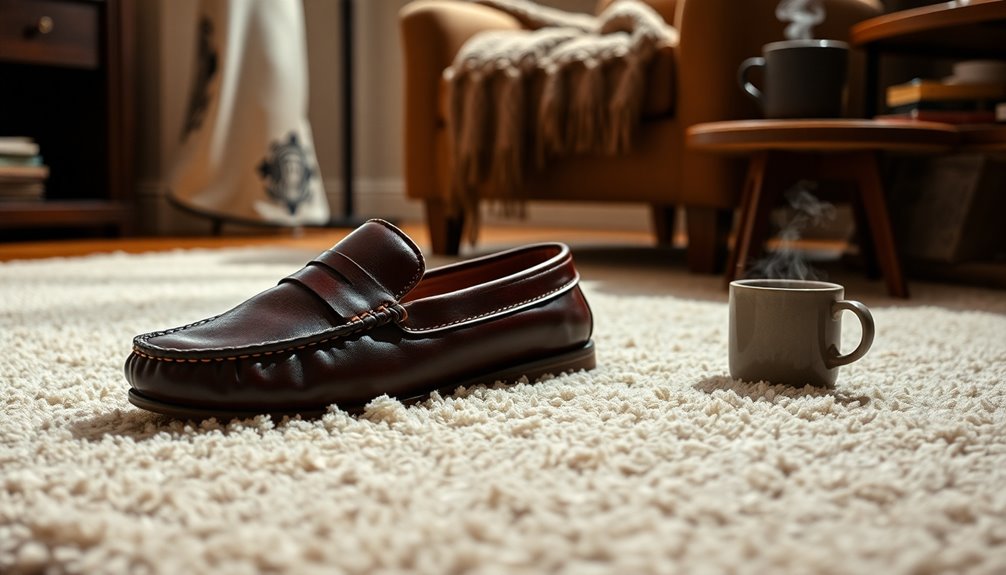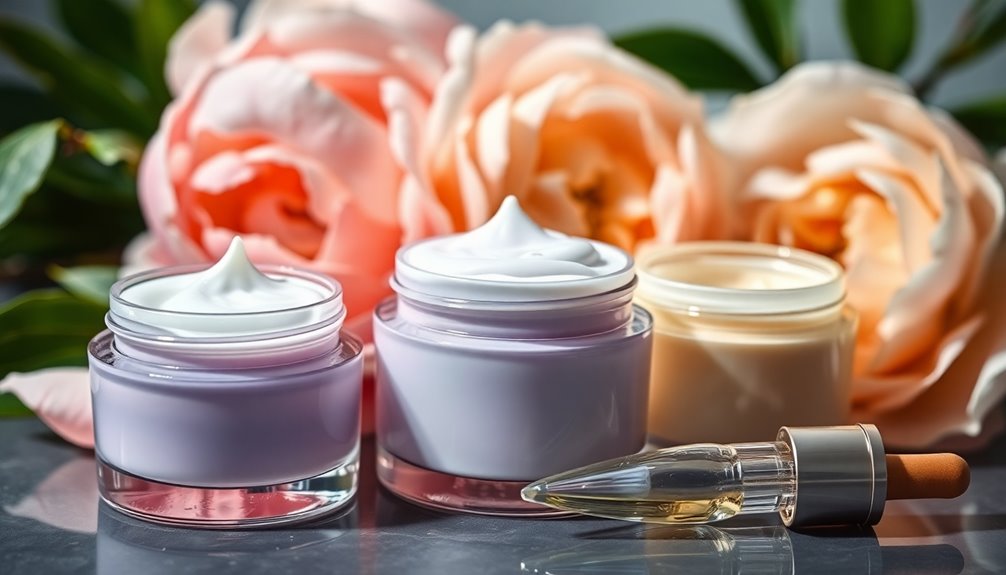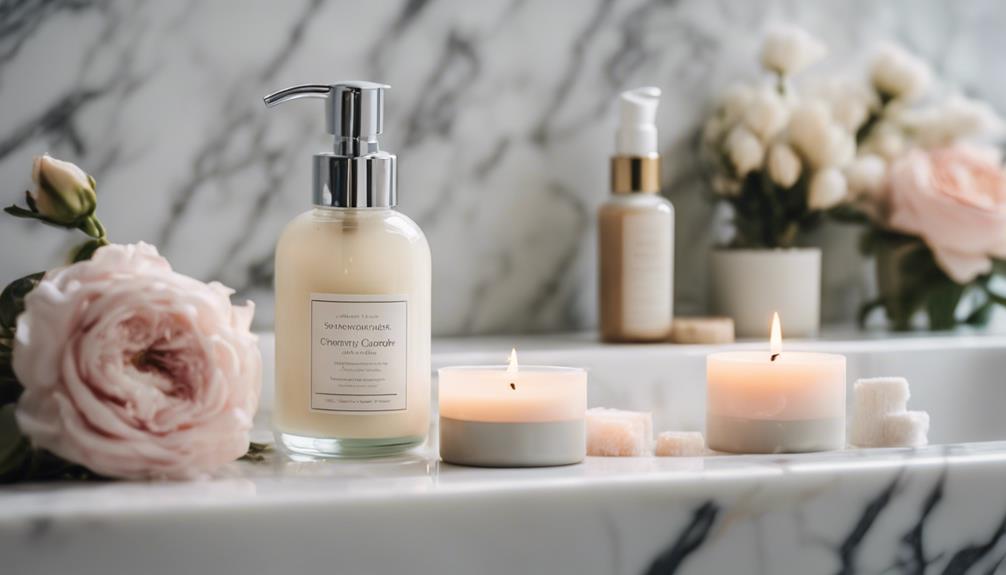Investing in a pair of quality slippers for men is an upgrade you won't regret. These comfortable footwear options often feature soft materials like shearling and sheepskin, ensuring warmth and breathability. Good slippers offer orthopedic support, alleviating foot pain and improving posture. Look for designs with non-slip soles for safety and traction around the house. With various styles available, you can find a pair that suits your aesthetic while keeping your feet cozy. By choosing the right slippers, you enhance your comfort and style effortlessly. Curious about which features to prioritize? You'll discover even more insight into making the best choice.
Key Takeaways
- Investing in high-quality materials like virgin wool and shearling ensures exceptional comfort and warmth for your feet.
- Orthopedic support features alleviate foot pain and promote healthy alignment, making slippers a practical choice for daily wear.
- Breathable, moisture-wicking materials manage temperature and odor, keeping your feet comfortable throughout the day.
- Non-slip soles provide reliable traction, enhancing safety on various surfaces, especially for those in need of extra stability.
- Choosing sustainable materials reflects a commitment to environmentally responsible practices, aligning with modern consumer trends.
Essential Materials for Comfort
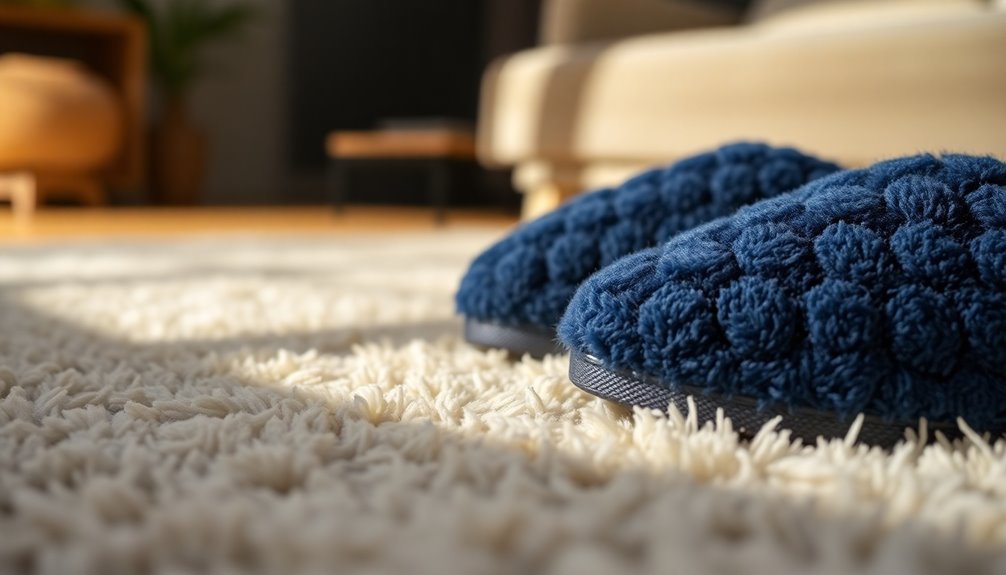
When it comes to finding the perfect slippers, comfort is key, and the materials used play a crucial role in achieving that. You'll want to consider options like virgin wool, which is incredibly soft and ideal for cozy slippers. Shearling is another great choice; it offers warmth while still allowing breathability, so your feet won't overheat. Full-grain leather brings flexibility and an anti-shock effect, making it perfect for padding around your home.
Don't overlook faux fur, especially if you live in a colder climate. It keeps your feet warm and comfortable. For added support, look for slippers with an EVA footbed; it enhances comfort with its cushioned feel. The durability of these materials has been evaluated in long-term tests, confirming their ability to withstand daily wear.
Breathability is also essential, particularly in warmer months. Cotton allows cool air to circulate, while natural rubber soles provide durability and breathability. Moisture-wicking materials, like Tencel lining and wool, help keep your feet dry and comfortable.
Choosing the right materials will not only elevate your comfort but also ensure that your slippers last longer. So, invest in quality materials, and your feet will thank you!
Importance of Orthopedic Support
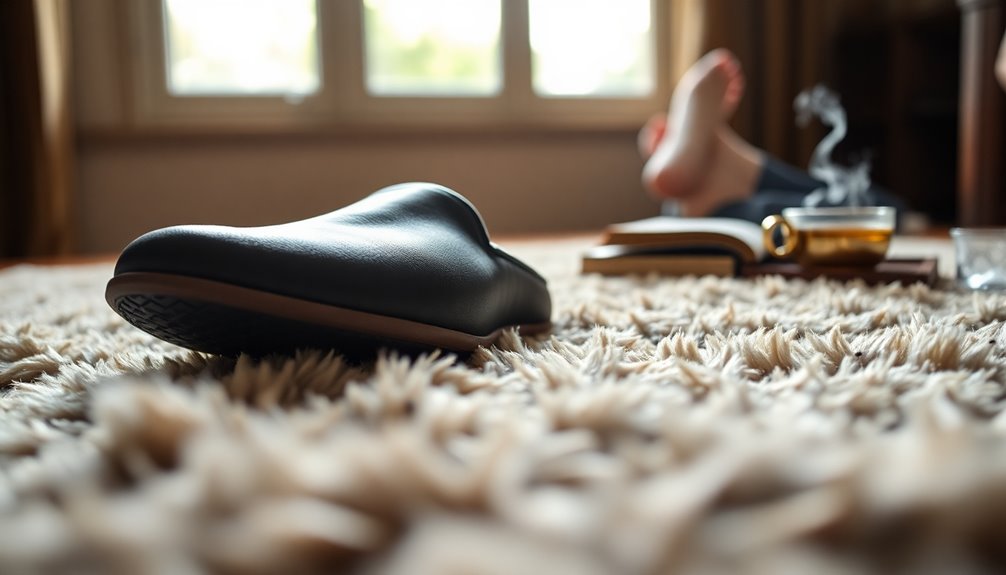
Orthopedic support in slippers is crucial for maintaining foot health and overall comfort. When you choose slippers with proper orthopedic features, you're taking a significant step toward alleviating foot pain associated with conditions like plantar fasciitis, arthritis, and bunions. The built-in orthotic insoles reduce strain on your feet, knees, and lower back, helping you feel more comfortable whether you're starting your day or winding down after a long one.
These slippers help maintain healthy foot alignment, which can improve your posture and reduce pain. By distributing pressure evenly, they lessen the strain on ligaments and tendons, making mobility easier. Features like deep heel cups are designed to correct mild to moderate pronation, cradling your arch and heel for additional support. Moreover, premium materials ensure that these slippers are not only supportive but also durable for prolonged use.
Furthermore, orthopedic support helps prevent injuries and conditions such as Achilles tendonitis, while providing shock absorption to minimize joint impact. With all these benefits, wearing orthopedic slippers not only enhances your comfort but also contributes to better sleep and overall foot health. Recommended by podiatrists, they're an essential investment for anyone looking to enhance their daily comfort and mobility.
Breathability and Moisture Management
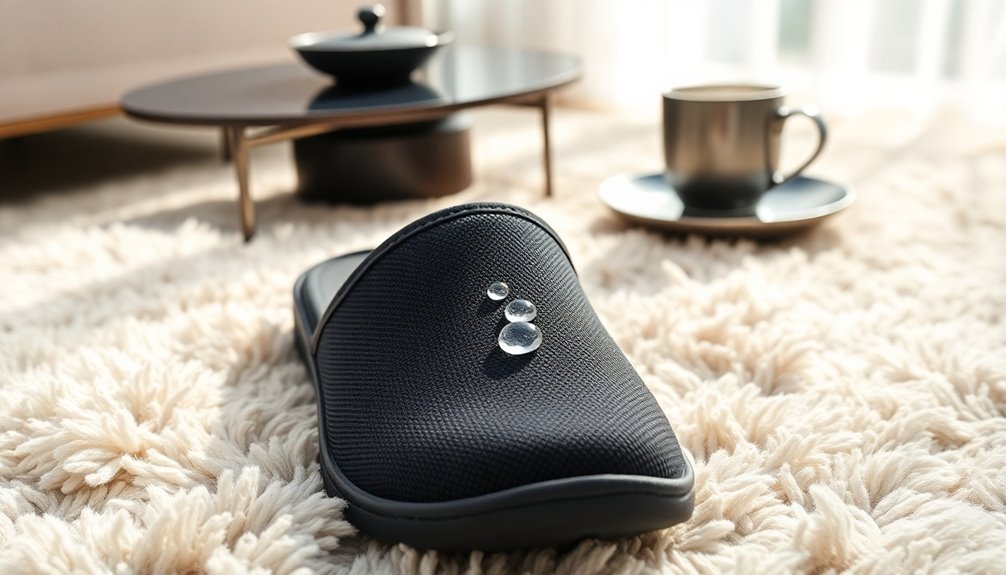
Breathability and moisture management are essential features to consider when choosing slippers for men. You want your feet to feel comfortable and dry, regardless of the season. Look for slippers made from natural materials like virgin wool or sheepskin. These materials allow air to flow around your feet, regulating temperature and preventing excess sweating. Breathable slippers quickly evaporate moisture, keeping your feet dry and comfortable.
Moisture-wicking properties in shearling and wool help absorb sweat, reducing the risk of dampness. This effective moisture management not only keeps your feet dry but also helps control odor by limiting bacterial growth. With slippers that offer these characteristics, you can maintain foot hygiene and comfort throughout the day. Additionally, slippers featuring natural rubber soles enhance breathability while providing durability. Giesswein Mens Slippers are crafted from soft virgin wool, ensuring that you enjoy the luxurious comfort of breathable materials. Remember, maintaining these slippers is easy; many can be washed in a machine, while sheepskin should be dried carefully to preserve its quality. By prioritizing breathability and moisture management, you'll ensure that your slippers remain a reliable source of comfort, no matter how long you wear them.
Traction and Safety Features
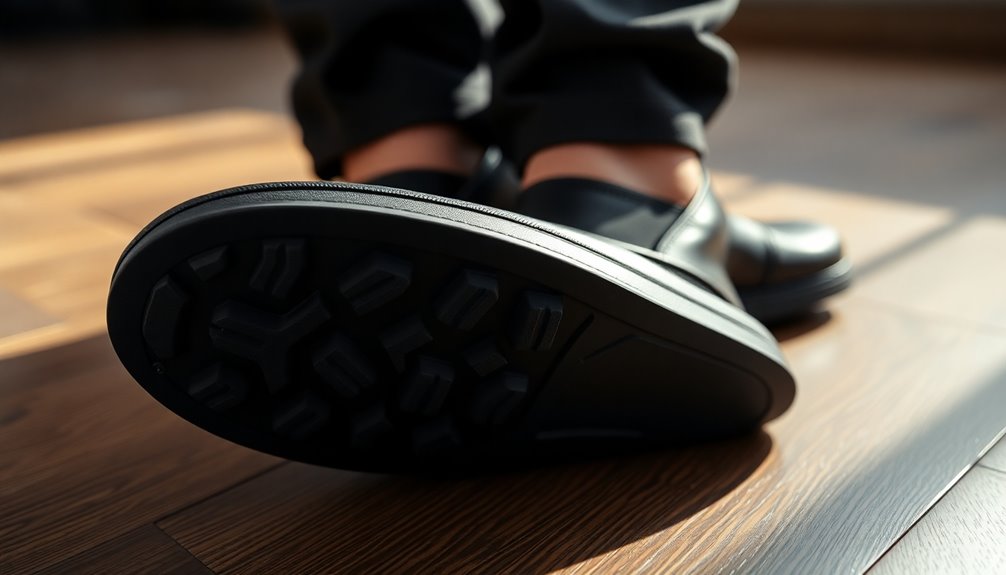
For those seeking comfort without compromising safety, traction and safety features are crucial in men's slippers. Non-slip soles made from robust rubber provide excellent grip on various surfaces, reducing the risk of falls in slippery areas like tiled bathrooms or carpeted hallways. Slippers such as the Minnetonka Pile Lined Hardsole and Orthofeet's models are designed to protect your feet from sharp objects and uneven ground, making them essential for anyone, especially the elderly. Additionally, the durable rubber outsoles found in slippers like the Minnetonka Pile Lined Hardsole offer reliable traction for both indoor and outdoor use, ensuring stability on wet surfaces. The thick soles found in slippers like the Minnetonka Pile Lined Hardsole guarantee a good grip, helping you navigate effortlessly.
Additionally, easy-to-wear designs, such as wide openings and hook-and-loop closures, promote safety by minimizing the effort required to put on or take off your slippers. This design feature is particularly beneficial for those with swelling or unique foot shapes, allowing for a secure fit that reduces the risk of falls. Investing in high-quality slippers with these traction and safety features means you can enjoy comfort while staying safe at home.
Key Comfort Features
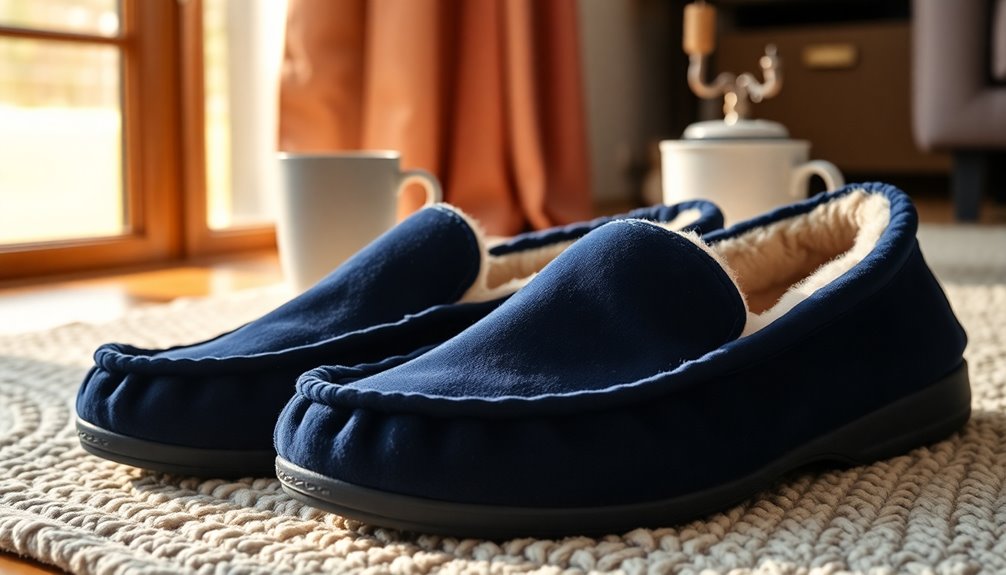
When it comes to comfort, choosing slippers with key features can make all the difference in your daily experience. Look for slippers that offer orthopedic support, which is crucial if you deal with conditions like plantar fasciitis or arthritis. Built-in arch support can alleviate pain and improve foot alignment, reducing strain on your feet, knees, and lower back. The PowerStep Men's Twin-Gore Slippers provide essential arch support for foot health, making them an excellent choice for those struggling with foot pain.
Cushioned comfort is another essential feature. Advanced cushioning technology absorbs shock, preventing foot and leg fatigue. Soft interiors and padded insoles create a luxurious feel, providing all-day relaxation and support.
Breathable materials are vital for keeping your feet dry and odor-free. Opt for slippers made from durable microfiber or lined with soft faux shearling. These materials help maintain a comfortable experience during long wear, preventing moisture buildup and keeping your feet fresh.
Finally, ensure you have an adjustable and tailored fit. Slippers with adjustable straps or elastic gore offer a secure fit for any foot shape, accommodating sensitive or aching feet. Finding the right size and width is crucial, so don't hesitate to try out different options for optimal comfort.
Stylish and Functional Designs
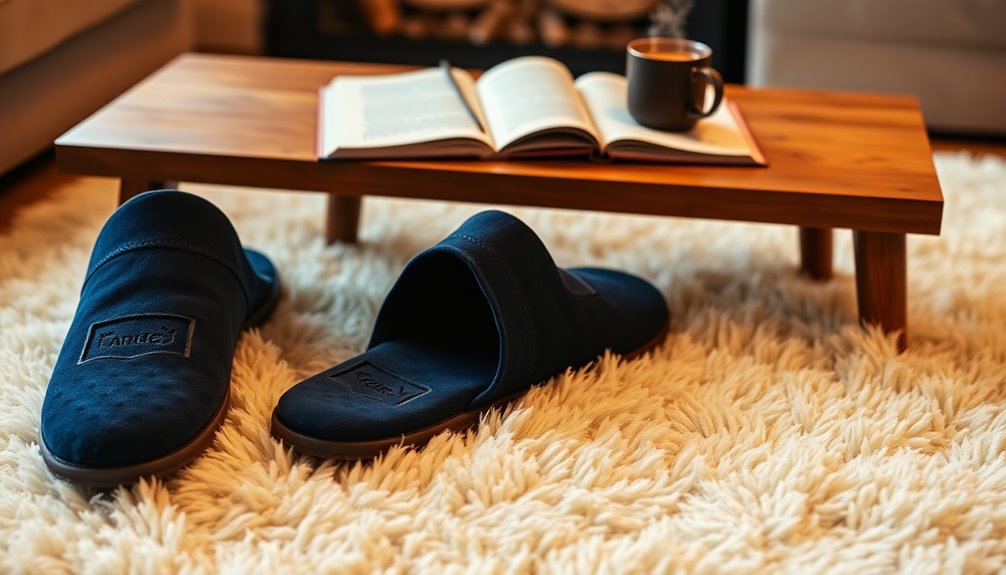
Stylish and functional designs in men's slippers blend aesthetics with practicality, ensuring you look good while enjoying comfort. You'll find luxurious materials like black belt leather, veg tan leather, and soft suede that elevate your wardrobe. Brands like Gucci and Versace offer iconic designs that merge classic elegance with modern flair, while Mahabis innovates with slippers that combine shoe features for added versatility. Additionally, many of these brands are focusing on sustainable luxury, ensuring that your comfort choices are also environmentally responsible. The emphasis on energy-efficient designs in various lifestyle products showcases a growing trend towards conscious consumerism.
Textures matter, too. Sheepskin in Minnetonka and UGG slippers provides unmatched warmth, while velvet and faux fur add a touch of sophistication. Rubber and neoprene soles ensure durability and grip, making your slippers suitable for both indoor lounging and quick trips outside.
With options ranging from hardsole to softsole designs, you can choose what suits your lifestyle best. Want something unique? Consider convertible slippers from OluKai or stylish moccasin designs from L.B. Evans. Metallic and colorful options from Mahabis let you express your personality while staying cozy.
Advanced features like water-resistant materials and genuine shearling linings enhance practicality, making these slippers a smart choice. You don't have to sacrifice style for comfort—stylish and functional slippers have it all.
Choosing the Right Slippers
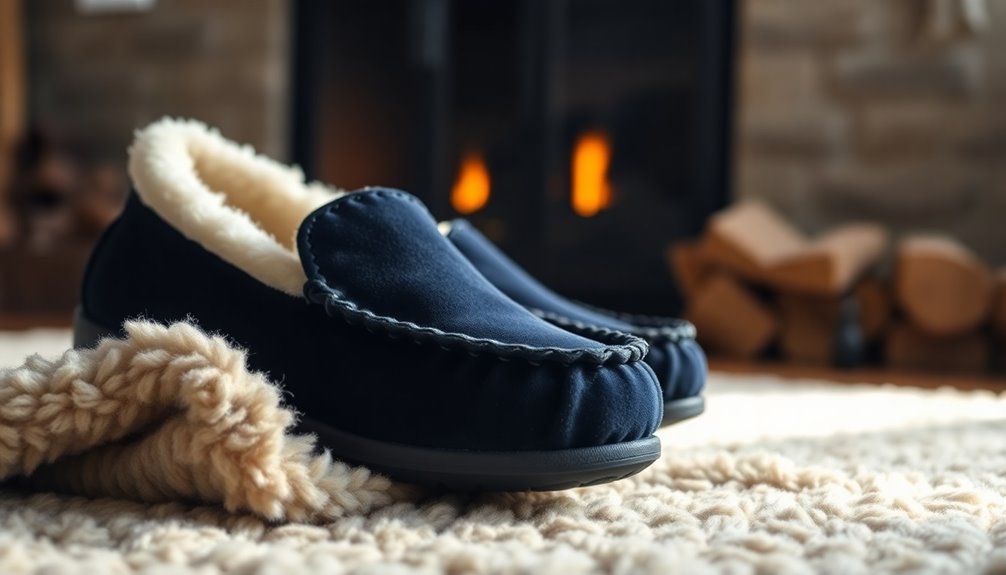
Finding the right slippers can make all the difference in your comfort and style at home. When choosing, consider material first. Leather and suede offer durability and mold to your feet, while wool and sheepskin keep your feet warm in winter and cool in summer. Cotton's lightweight nature is perfect for warmer climates, and synthetic materials provide easy maintenance. Additionally, ideal mens outdoor slippers enhance daily activities by ensuring both comfort and style.
Next, pay attention to the sole quality. Rubber soles offer excellent traction and durability, making them ideal for outdoor use. Look for non-slip soles to prevent slips on various surfaces. Cushioning and support are vital; memory foam insoles and built-in arch support can alleviate discomfort and reduce foot fatigue.
Fit is crucial, too. You want a snug fit without it being too tight, allowing for natural movement. Adjustable straps can help provide a personalized fit. Lastly, consider additional features like moisture-wicking properties to keep your feet dry and removable insoles for easy cleaning. By weighing these factors, you can confidently choose slippers that enhance both your comfort and style at home.
Frequently Asked Questions
How Do I Clean and Maintain My Slippers?
To clean and maintain your slippers, start by dusting them off with a soft brush. For general cleaning, soak them in a mild soap solution for 15-20 minutes, then scrub with a toothbrush. Rinse with cool water and air dry. For leather, use a damp cloth and leather conditioner. Regularly wipe them down and sprinkle baking soda if they smell. Avoid machine washing; hand cleaning keeps them in great shape.
What Sizes Do Men's Slippers Typically Come In?
Men's slippers typically come in standard sizes, ranging from small to extra-large. You'll find sizes like US 7-14, with UK and EU equivalents as well. Width options include narrow, standard, wide, and extra wide, ensuring you get a comfortable fit. Some brands even offer half sizes or adjustable options, which can be great if you're between sizes. Always check specific sizing charts for the best fit, as sizing can vary by manufacturer.
Are There Slippers Suitable for Wide Feet?
Yes, there are definitely slippers suitable for wide feet. You'll find options available in sizes that cater to extra wide fittings, often ranging up to 5E. Brands like Xlfeet and Cosyfeet offer designs specifically made for swollen or very wide feet, ensuring you get the comfort and support you need. Look for features like arch support and ergonomic footbeds to enhance your comfort even further. You won't regret investing in a pair!
Can Slippers Be Worn Outside Frequently?
Yes, you can definitely wear slippers outside frequently, but it's essential to choose the right ones. Look for slippers with durable, grippy rubber soles for traction and stability. Materials like leather or wool will offer comfort and insulation, making them suitable for various weather conditions. Just be mindful of the slipper's design and care requirements to ensure they last through outdoor adventures while keeping your feet cozy and protected.
How Long Do High-Quality Slippers Usually Last?
High-quality slippers usually last anywhere from 1 to 3 years, depending on how you use them. If you wear them occasionally indoors, they can easily last several years. However, with daily use, especially for lounging or light activities, expect around 2 to 3 years. If you wear them heavily or outdoors, their lifespan might drop to just 1 to 2 years. Proper care can significantly extend their durability, so keep them clean and well-maintained!
Conclusion
In the end, investing in a pair of comfortable slippers is a decision you won’t regret. With the right materials, orthopedic support, and stylish designs, you’ll enjoy every moment spent in them. Prioritize breathability and safety features to keep your feet happy and secure. Remember, the perfect pair is out there just waiting for you. So, treat yourself to that comfort upgrade—you deserve it! Your feet will thank you for it every step of the way. For those seeking the ultimate in relaxation, exploring options like kane footwear comfort levels can elevate your experience even further. With innovative designs that cater to your unique foot shape, you can find slippers that not only look good but also enhance your overall well-being. So go ahead, indulge in a pair that brings joy to your downtime and keeps your feet pampered throughout the day.
